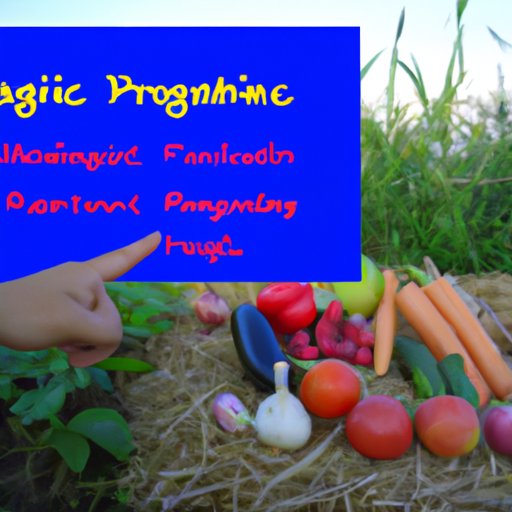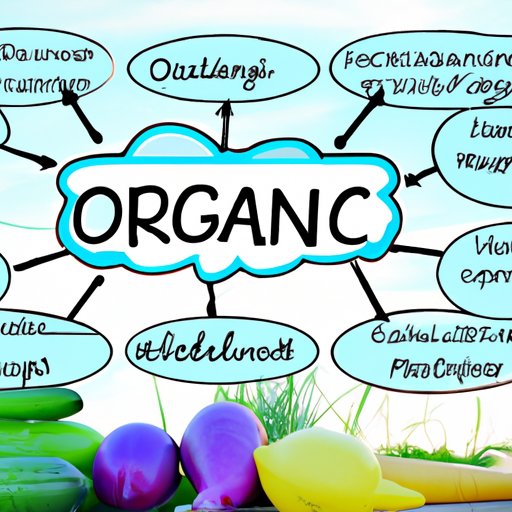Introduction
When it comes to food choices, one of the most common questions people ask is, “Is organic healthier?” With so much information out there, it can be hard to know what to believe. To help you make informed decisions about your food choices, this article takes an in-depth look at the benefits and risks of organic versus non-organic foods.
Organic foods are those that have been produced without the use of synthetic pesticides, fertilizers, or other artificial chemicals. Non-organic foods, on the other hand, are grown with the use of these chemicals and may contain traces of them. This article will explore the potential health benefits and risks associated with eating organic versus non-organic foods, as well as the cost difference between the two, the environmental impact, and the nutritional value.
Examining the Benefits of Organic Foods
One of the primary benefits of eating organic foods is the potential to avoid exposure to harmful pesticides, hormones, antibiotics, and other chemicals. According to a study published in Environmental Health Perspectives, children who ate organic produce had significantly lower levels of organophosphate pesticide metabolites in their urine than those who did not consume organic fruits and vegetables. This suggests that organic foods may help reduce exposure to potentially hazardous chemicals.
In addition to avoiding exposure to chemicals, choosing organic foods can also help support local farmers and the environment. Organic farming practices promote soil health, conserve water, and reduce pollution from agrochemicals. Eating organic can also help ensure that animals are raised humanely and that workers are treated fairly.
Exploring the Health Risks of Eating Non-Organic Food
While organic foods have many potential health benefits, non-organic foods may pose some health risks. For example, conventional agriculture often involves the use of pesticides, hormones, and antibiotics, which can lead to increased exposure to these potentially hazardous chemicals. Additionally, many non-organic foods are genetically modified organisms (GMOs), which have been linked to numerous health issues, including allergies and cancer.
A Look at the Cost Difference Between Organic and Non-Organic Foods
Organic foods tend to be more expensive than their non-organic counterparts, but there are ways to save money when buying organic. Buying in bulk, shopping at farmers markets, and growing your own produce are all great ways to save money while still getting the benefits of organic foods. Additionally, many stores offer coupons and discounts on organic products, so be sure to take advantage of these whenever possible.
Investigating the Environmental Impact of Organic vs Non-Organic Agriculture
Organic farming practices have been shown to have a positive effect on the environment. By reducing the use of synthetic fertilizers, herbicides, and pesticides, organic farming helps protect soil quality, conserve water, and reduce air and water pollution. Additionally, organic farms are often more biodiverse than conventional farms, providing habitat for beneficial insects and wildlife.
Analyzing the Nutritional Value of Organic vs Non-Organic Produce
Organic produce may also have higher levels of vitamins and minerals than non-organic produce. A study published in The British Journal of Nutrition found that organic tomatoes had higher levels of antioxidants and vitamin C than conventional tomatoes. Additionally, organic produce has been found to have lower levels of heavy metals, such as cadmium and lead, which can be toxic if consumed in large amounts.

Comparing Labeling and Certification Standards for Organic Products
When it comes to buying organic foods, it’s important to make sure that they are properly labeled and certified. The United States Department of Agriculture (USDA) National Organic Program sets strict standards for organic production and labeling, and any product labeled “organic” must meet these standards. There are also other certification programs, such as the Certified Naturally Grown program, which sets similar standards for organic production.

Understanding How to Choose Organic Foods for Optimal Health
When it comes to choosing organic foods, it’s important to read labels carefully and check for certifications. Additionally, it’s helpful to shop at farmers markets and join Community Supported Agriculture (CSA) programs to get access to fresh, locally grown organic produce. Finally, it’s important to remember that organic doesn’t always mean healthy—processed organic foods, such as cookies and chips, are still high in calories and low in nutrition.
Conclusion
Organic foods have many potential health benefits, including the potential to avoid exposure to pesticides, hormones, and other potentially hazardous chemicals. They are also better for the environment and may have higher levels of vitamins and minerals than non-organic produce. However, organic foods can be more expensive than non-organic foods, and it’s important to read labels and check for certifications to ensure that they are truly organic. When it comes to choosing organic foods for optimal health, it’s important to focus on fresh, whole foods and to limit processed organic foods.
(Note: Is this article not meeting your expectations? Do you have knowledge or insights to share? Unlock new opportunities and expand your reach by joining our authors team. Click Registration to join us and share your expertise with our readers.)
